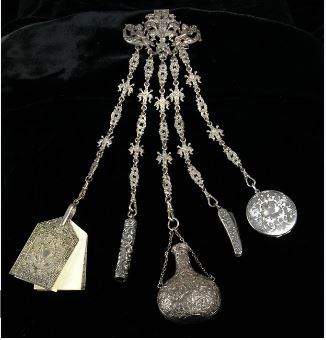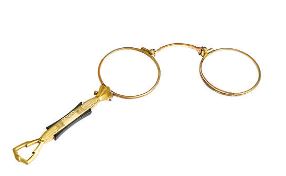No products

Estate Jewelry Glossary
Owning a piece of history is a remarkable experience. Whether it's a captivating ring, an exquisite hairpin, or a dazzling bracelet worn by a stylish individual from a bygone era, it connects us to our collective past. Estate jewelry holds a treasure trove of antiques waiting to be worn and admired. Whether you're seeking fashion-forward pieces or timeless vintage gems, navigating the terminology of yesteryears can be daunting. Our estate jewelry glossary is your ultimate guide to exploring vintage and antique jewelry for your collection.
 |
Art Nouveau: The Art Nouveau design movement bridged the transition to the modern era of the 20th century. It was influenced by Egyptian, Japanese (or Japonisme), Scandinavian, British, and American cultures. The period for Art Nouveau, meaning New Art, is approximately 1875 to 1920 and is distinguished by curvilinear patterns and nature-based motifs, such as vines, flowers and animals. Jewelry usually featured more than one gemstone. Winged creatures, dragons, griffins, and insects are featured heavily. Mythological figures like Medusa or mermaids were also at the center of Art Nouveau jewelry. |
 |
Art Deco: The prewar design movement called Art Deco dates to 1925 to 1939. The Art Deco term comes from the exhibition “Exposition International des Arts Décoratifs et Industriels Modernes,” held in Paris in 1925. In some ways an extension of Art Nouveau, Art Deco design is marked by bold colors and geometric designs. Compared to previous eras, jewelry now featured straight lines, geometrical designs, sharp angles, and, as far as engagement rings were concerned, one center stone. The new style used platinum more frequently than yellow gold, a unique gem-cutting style, a lacquer technique highlighting the influence of the industrial period, and more. Antique jewelry from the Art Deco period is a popular collector's item. |
 |
Bakelite: This durable plastic, produced under heat and pressure, can be molded or carved into almost any shape. Brightly colored versions of bakelite are featured often in jewelry from the 1930s. |
 |
Cabochon: This decorative bead made of a gem or other organic material has a smooth domed shape. Large cabochons of opal, sapphire and ruby often appear often in antique rings. |
 |
Cameo: A cameo is a portrait, usually of a woman, carved in low-relief style on a stone, gem or other organic material. The carving is set in a frame to become a brooch, pendant or other decorative personal item |
| Champlevé: The first step in producing this enamel is to carve out channels or engrave a design into a metal base. The metal base is thicker than it is in cloisonné enamel. Through the process of carving the metal a relief of an image is created. This relief is then filled with different colored enamels, usually opaque. | |
 |
Chatelaine: A chatelaine is a chain that holds implements such as keys, scissors, eyeglasses and other personal belongings; a woman wore it at the waist. |
 |
Claw setting: The claw setting features a circle of long prongs that clasp a large gemstone to a band, pendant or chain. |
 |
Cloisonné: This enamel is made using thin strips of flattened wire that are adhered to a base. Different sections of the design can be filled with different colored enamel. The wire remains visible in the finished piece and acts as an outline for the finished design. |
| Doublet and triplet: A doublet is a thin layer of natural stone adhered to a backing material. The doublet backing material is used to thicken and give strength to the gem. The addition of a clear, protective layer on top of a doublet forms a triplet gemstone form, which gives additional strength to the item. This top layer consists of clear quartz, glass or hard plastic. | |
 |
Edwardian: Edwardian refers to styles popular during the early years of the 20th century prior to World War I, especially during the reign of King Edward VII of Great Britain (1901 to 1910). The period style is marked by elegance that is lighter and more restrained than the heavy, ornate designs of the preceding Victorian Era. Silver and platinum were more popular than yellow gold, and an airy, filigree style was very common. |
| Émail en ronde bosse: This style of enamel become very popular during the Art Nouveau period, although it was invented much earlier. While all the other enameling techniques are applied to a flat base, this style is applied to 3-dimensional shapes. Before applying the enamel, a gum or glue to painted onto the surface. The enamel adheres to this base layer and when the enamel is heated the gum or glue melts away, while the enamel remains intact. | |
 |
Enamel: This paint, varnish or protective coating dries to a hard, glassy finish, features many colors and often has a brilliant shine. |
| Guilloche: This enameling technique was invented by Carl Fabergé. I know what you’re wondering, and yes, that is the egg guy. Guilloche enamel combines engraving with transparent or opalescent enamel. The enamel sits on top of an engraved base. The transparent enamel allows the design to show through. | |
 |
Lorgnette: A lorgnette is a pair of glasses that are mounted on a handle that is used to hold the glasses to the eyes. |
 |
Millefiore: These blown-glass pieces feature multicolored and transparent glass fused together into a pattern, usually a floral design. |
 |
Mine cut: This diamond cut features a square with rounded corners and a round girdle. Dating from the 1700s, this design is an early version of today's brilliant cut. It is also called old mine cut. |
| Plique A Jour: This enameling technique uses the same jewellery enamelling technique as the Cloisonné technique by using metal wires to create individual cells. The only difference between the two being that this enamelling technique does not use any backing, allowing the light to shine directly through the enamel – similar in effect to stained glass windows. | |
| Retro: For estate jewelry, this term often refers to a style popular during the 1940s that featured large pieces and geometric shapes. | |
 |
Rose cut: This traditional cut for diamonds features a flat base and triangular facets that culminate in a point on top of the stone. The rose cut is rarely used today but can be seen in diamond jewelry dating from the early 20th century or earlier. |
 |
Sautoir: Popular during the Edwardian Era, a sautoir is an extra-long necklace that has a tassel or large pendant as the centerpiece; these long necklaces are also called rope necklaces. |
| Seed pearls: Seed pearls are tiny natural or faux pearls that decorate jewelry, accessories and personal implements such as boxes and mirrors. Usually, many pearls will adorn a piece. | |
 |
Signet: A signet is a personal implement, such as a ring, that has an engraved seal or name that identifies the owner and his elevated social status or occupation. |
 |
Vermeil: Vermeil is a gold-plating process in which 18-karat yellow gold is plated over a sterling silver object. |
During the 1970s I began making and selling jewellry, a passion I shared with my mum, through local businesses. Together, we made hundreds of pieces of everyday accessories to wedding accessories. From 1980 to 1993 I was an integral part of the team of successful small business entrepreneurs behind Boaz Junction, a local women's wear store here in St. Catharines, Ontario.







